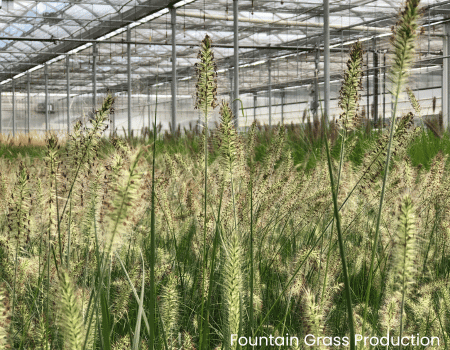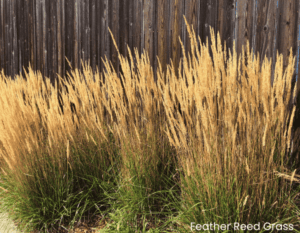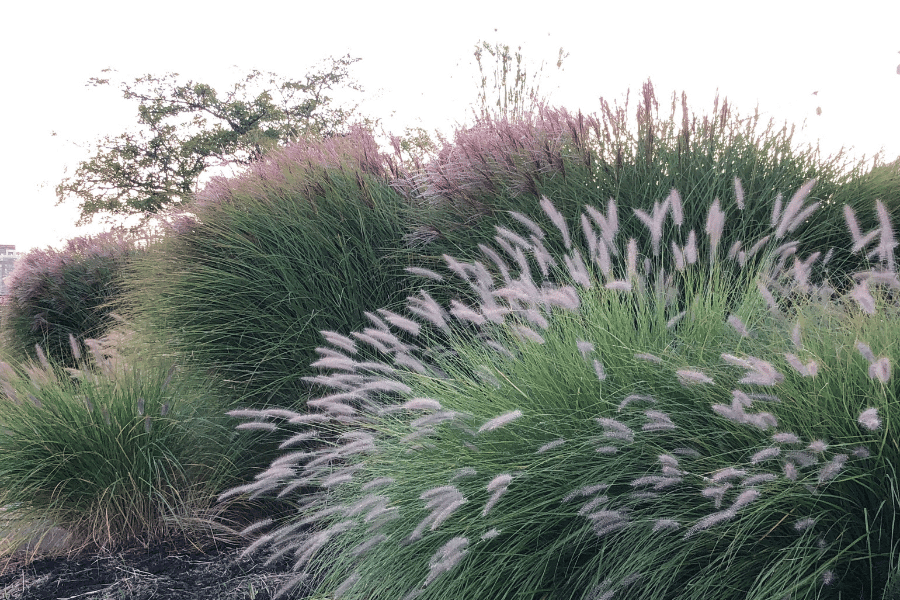In the world of gardening, few elements can rival the elegance and allure of perennial ornamental grasses. With their graceful sway, mesmerizing textures, and year-round appeal, these versatile plants have secured their place as a beloved addition to gardens and landscapes. Delve into the captivating beauty of perennial ornamental grasses and explore the many reasons why they have become a staple for both seasoned and novice gardeners.
Effortless Elegance
One of the most enchanting aspects of perennial ornamental grasses lies in their effortless elegance. With minimal care, these resilient plants flourish and add a touch of sophistication to any garden. Their arching blades dance gracefully in the breeze, creating a sense of movement that transforms the landscape into a living, breathing canvas. Whether planted as a border, used as a focal point, or integrated into mixed perennial beds, ornamental grasses infuse an air of enchantment and tranquility to the surroundings.
Versatility in Design
Perennial ornamental grasses come in a stunning array of sizes, colors, and textures, providing endless possibilities for creative landscape design. From the fine, feathery plumes of Feather Reed Grass (Calamagrostis x acutiflora) to the bold, showy foliage of Japanese Silver Grass (Miscanthus sinensis), there’s a grass variety to suit every taste and theme. Whether you desire a contemporary, minimalist garden or a lush, naturalistic oasis, ornamental grasses can be artfully integrated to elevate the aesthetics of any space.
Four Seasons of Interest
One of the greatest advantages of perennial ornamental grasses is their ability to captivate throughout the year. While some plants might steal the spotlight during a particular season, ornamental grasses ensure there is never a dull moment in your garden. During the spring and summer, they produce delicate inflorescences that sway gracefully, creating a dreamy, ethereal atmosphere. In autumn, their foliage transforms into warm hues of gold, copper, and bronze, adding a spectacular display of color. Even in winter, many grasses maintain their structure, providing a beautiful contrast against the snow and infusing the garden with a sense of life during colder months.
Low Maintenance Champions
For gardeners with busy schedules or those seeking low-maintenance options, perennial ornamental grasses are a dream come true. Once established, these hardy plants require minimal care, making them a popular choice for both novice and experienced green thumbs alike. Their deep root systems make them tolerant to drought, and they generally thrive in a wide range of soil conditions. With minimal pruning and occasional division to control growth, these grasses will reward you with their timeless beauty year after year.
Eco-Friendly Landscaping
In an era where sustainability and environmental consciousness are at the forefront of our minds, perennial ornamental grasses prove to be a valuable addition to eco-friendly landscaping. These native or adaptive plants often require fewer resources to thrive, reducing the need for excessive watering and fertilization. Additionally, their dense root systems help prevent soil erosion and provide a habitat for beneficial insects and small wildlife. By incorporating ornamental grasses into our landscapes, we contribute to a more biodiverse and resilient ecosystem.
Supporting Pollinators
Beyond their aesthetic appeal, ornamental grasses play a crucial role in supporting pollinators. Many grass species produce inflorescences laden with nectar and pollen, attracting bees, butterflies, and other pollinating insects. These plants become essential fuel stations for these vital creatures, fostering biodiversity and helping maintain the delicate balance of the ecosystem.
Whether you seek to enhance your landscape with a touch of serenity or create a habitat for wildlife, ornamental grasses offer the perfect solution. When it comes to choosing ornamental grasses for height, there are several stunning options available. Consider the climate and space available in your garden, as some of these grasses can spread quite wide as well. Proper placement and maintenance will ensure that these impressive grasses become the focal point of your landscape, adding beauty and drama to your outdoor space.


Here is a list of some of the best ornamental grasses (zone 5) known for their impressive height:
- Pampas Grass (Cortaderia selloana): Pampas grass is a majestic giant that can reach heights of 8 to 12 feet or more. Its large feathery plumes create a dramatic display in late summer and fall, adding a touch of elegance to the landscape.
- Zebra Grass (Miscanthus sinensis ‘Zebrinus’): Zebra grass grows to a height of 5 to 8 feet, featuring distinct horizontal gold banding on its leaves. The showy reddish plumes in late summer add to its charm.
- Indian Grass (Sorghastrum nutans): Indian grass can grow 5 to 7 feet tall and is known for its striking golden-yellow fall color. It adds a touch of elegance to prairie-style and naturalistic gardens.
- Switchgrass (Panicum virgatum): Depending on the variety, switchgrass can grow anywhere from 3 to 8 feet tall. It comes in various colors, including blue-green, red, and burgundy, and produces airy panicles in late summer.
- Big Bluestem (Andropogon gerardii): A native prairie grass, big bluestem can reach heights of 5 to 8 feet. Its upright growth and reddish-bronze fall color provide both visual interest and wildlife habitat.
- Feather Reed Grass (Calamagrostis x acutiflora): Although not as tall as some other grasses on this list, feather reed grass can still reach heights of 4 to 6 feet. Its narrow, upright growth habit and feathery flower heads make it an excellent accent plant.

- Silver Grass (Miscanthus sinensis): Many varieties of Miscanthus sinensis can grow between 5 to 8 feet tall. They are prized for their graceful arching form and magnificent plumes that emerge in late summer.
- Eulalia Grass (Miscanthus sinensis ‘Gracillimus’): This cultivar of Miscanthus sinensis grows to around 6 to 8 feet tall and features narrow, arching leaves with silver midribs. Its coppery plumes in late summer are a sight to behold.
- Giant Silver Grass (Miscanthus giganteus): As the name suggests, this grass can grow to towering heights of 10 to 12 feet. It forms massive clumps of green foliage with silvery plumes in late summer.
- Northern Sea Oats (Chasmanthium latifolium): While not as tall as some others on this list, Northern Sea Oats can still reach heights of 3 to 5 feet. The unique flat seedheads, resembling flattened oats, add texture and movement to the garden.
Space doesn’t always permit the use of graceful giants, and short, tufting varieties of ornamental grasses are perfect for adding texture and interest to small garden spaces or for creating low-maintenance borders and groundcovers. Tucked into planters, ornamental grasses make stunning statements at entrances, on patios, and poolside.
Here is a list of some delightful short tufting ornamental grasses:
- Little Bluestem (Schizachyrium scoparium): This native grass forms compact tufts and typically reaches a height of 2 to 3 feet. It displays stunning blue-green foliage that turns shades of red, orange, and purple in the fall.
- Blue Fescue (Festuca glauca): Blue fescue is a popular ornamental grass with tufted mounds of slender, blue-gray foliage. It grows to around 1 to 2 feet tall and works wonderfully in rock gardens and border edging.
- Japanese Forest Grass (Hakonechloa macra): This graceful grass forms cascading tufts of arching foliage, adding a touch of elegance to shaded areas. It typically grows to about 1 to 2 feet in height.
- Elijah Blue Fescue (Festuca glauca ‘Elijah Blue’): A cultivar of blue fescue, Elijah Blue has more intense blue coloring and forms tidy tufts about 1 foot tall. It’s an excellent choice for small spaces and container gardening.
- Tufted Hair Grass (Deschampsia cespitosa): This cool-season grass forms neat, tufted clumps that grow to around 2 to 3 feet tall. It produces delicate, airy flower heads in late spring to early summer.
- Prairie Dropseed (Sporobolus heterolepis): Prairie dropseed forms loose tufts of fine, green foliage and grows to about 2 to 3 feet tall. Its fragrant flowers create a beautiful and unique addition to the landscape.
- Korean Feather Reed Grass (Calamagrostis brachytricha): This tufting grass features narrow, arching leaves and produces feathery flower plumes in late summer and fall. It reaches a height of about 2 to 3 feet.
- Black Mondo Grass (Ophiopogon planiscapus ‘Nigrescens’): Although technically not a true grass, black mondo grass is often used as a grass-like groundcover. It forms dense tufts of dark, almost black foliage, and grows to about 6 to 8 inches tall. Note that we find this one does best in protected areas.
- Little Bluestem ‘The Blues’ (Schizachyrium scoparium ‘The Blues’): This is a shorter cultivar of little bluestem, growing to about 2 feet tall. It retains its blue coloring throughout the season and has a compact, tufted habit.
- Japanese Blood Grass (Imperata cylindrica ‘Rubra’): Another grass-like plant, Japanese blood grass forms tight tufts of green leaves that turn brilliant shades of red as the season progresses. It typically reaches a height of 1 to 2 feet.
Made for Shade
A common site condition, shade locations can be difficult to plant with specimens that will thrive and be prolific without the full sun. However, there are still several beautiful and adaptable ornamental grasses that can thrive in partial to full shade conditions. Here are some of the best ornamental grasses for shade in zone 5:
- Japanese Forest Grass (Hakonechloa macra): This graceful grass is well-suited for shade gardens. It forms cascading mounds of arching foliage in shades of green, gold, or variegated combinations. Japanese forest grass is known for its striking appearance and ability to tolerate shade.
- Autumn Moor Grass (Sesleria autumnalis): This cool-season grass is shade-tolerant and forms neat tufts of fine green foliage. It produces attractive flower spikes in late spring to early summer. Autumn moor grass is a reliable option for adding texture to shaded areas.
- Tufted Hair Grass (Deschampsia cespitosa): This versatile grass can grow in both sun and shade, making it suitable for various garden settings. It forms tufted mounds of narrow, arching foliage and produces delicate, airy flower heads that add a touch of elegance to the landscape.
- Northern Sea Oats (Chasmanthium latifolium): Northern sea oats are well-adapted to shade conditions and bring unique charm to the garden. Its bamboo-like foliage is topped with flat, decorative seedheads that sway gracefully in the breeze.
- Japanese Sweet Flag (Acorus gramineus): While not a true grass, Japanese sweet flag is often used as a grass-like groundcover in shade gardens. It features tufts of attractive, grass-like foliage in shades of green or variegated with cream.
- Japanese Sedge (Carex morrowii): Japanese sedge is an excellent shade-tolerant option with dense tufts of arching, grass-like leaves. It comes in various cultivars with different colors and textures, adding versatility to the landscape.
- Bowles’ Golden Sedge (Carex elata ‘Aurea’): This bright golden-yellow sedge thrives in partial to full shade conditions. Its striking color brings a splash of brightness to shaded areas, making it a valuable addition to the garden.
The next time you stroll through a well-designed garden or park and feel a sense of tranquility wash over you, take a moment to appreciate the quiet grandeur of the perennial ornamental grasses that sway gently in the breeze, reminding us of the inherent beauty in simplicity and the enduring allure of nature’s masterpieces.




